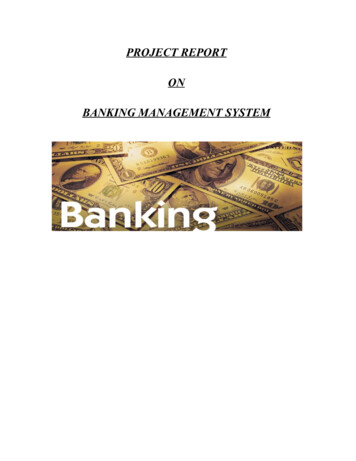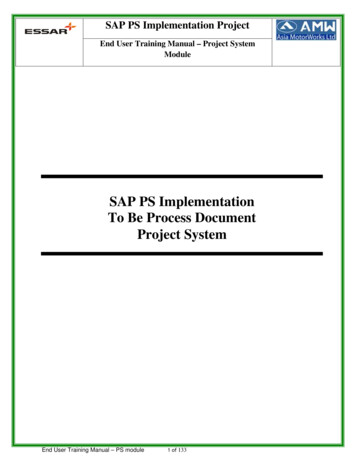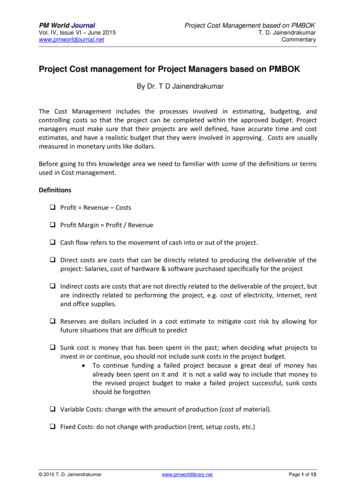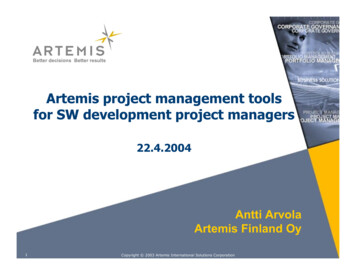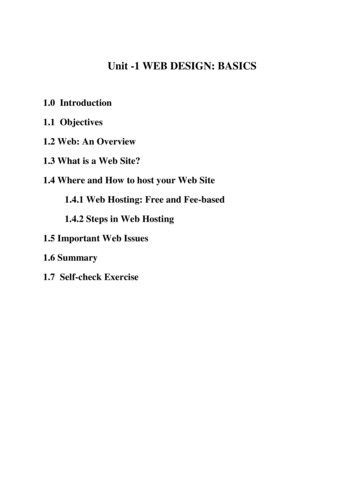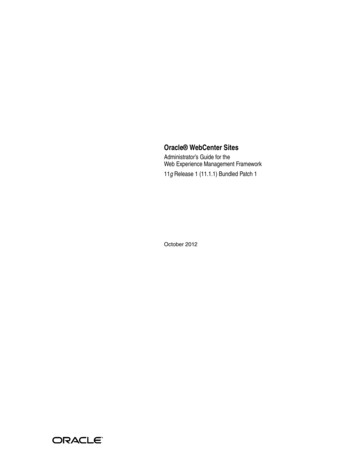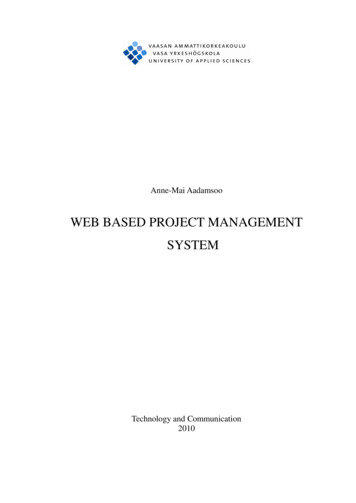
Transcription
Anne-Mai AadamsooWEB BASED PROJECT MANAGEMENTSYSTEMTechnology and Communication2010
VAASAN AMMATTIKORKEAKOULUUNIVERSITY OF APPLIED SCIENCESDegree Program of Information TechnologyABSTRACTAuthorAnne-Mai AadamsooTitleWeb Based Project Management SystemYear2010LanguageEnglishPages57Name of Supervisor Ghodrad MoghadampourTo increase an efficiency of a product, nowadays many web developmentcompanies are using different project management systems. A company may run anumber of projects at a time, and requires input from a number of individuals, orteams for a multi level development plan, whereby a good project managementsystem is needed.Project management systems represent a rapidly growing technology in ITindustry. As the number of users, who utilize project management applicationscontinues to grow, web based project management systems enter a critical role ina multitude of companies. Thus, a proper project management system plays adistinctive part in ensuring reliable, robust and high quality web applications forcustomers. Developing a web based project management system and showinghow, in turns, it helps users to handle projects. These processes in everyday sworking life, is the scope of the thesis. The reliability and robustness of a webbased project management system has also been set as the structure of the currentthesis. Finally, a web based project management system has been developed,which highly meets the standards and requirements set by the company. The webbased project management system uses an already integrated TRAC applicationthat has improved to suite companies needs.KeywordsProject management, Resource management, Quality assurance
3CONTENTSWEB BASED PROJECT MANAGEMENT SYSTEM . 11. INTRODUCTION . 41.1 Background of Project Management . 61.2 Motivation . 81.3 General description of the project . 102. PROJECT SPECIFICATION . 122.1 Analysis and design . 132.2 Limitations. 182.3 General Function Description . 182.3.1 Requirements . 192.3.2 Requirements for a Web Development Process . 202.4 Modelling . 212.4.1 Main functionalities . 222.4.2 Detailed description of main functionality . 232.5 Architecture . 293. IMPLEMENTATION . 323.1 Functional requirements . 334. TESTING . 495. CONCLUSION . 55REFERENCES. 57
41. INTRODUCTIONWeb based project management systems are designed to manage and store projectinformation that are used in web-based applications. By different groups of peoplesuch as, seals department, programmers or project managers will be let by projectapplications a controlled access to information and automated distribution ofinformation.The objective for collaboration has been: getting thing done faster, cheaper andbetter by applying their common knowledge, bringing together a selection ofresources and attainments in a project. Because valid collaboration with teamsimproves productivity, speeds up result-making and optimizes of making a rightdecisions, it also helps to intercept precious intellectual fortune and time. Webbased project management system can surprisingly increase performance,productivity and efficiency within an organization. Since web-based applicationscan be accessed through any web browser, no desktop installation or updates arerequired. Moreover, developers, who write great code while staying out of theway are able to use it along the distance, while they stay in geographicallydifferent place and collaboration between team still exists. Please find a shortoverview of the system as described in Figure 1-1 below. The aim of the Figure isto provide the background of the system conducted. The background of the systemincludes an introduction to the system area and the motivation behind thedevelopment and research.
5Figure 1-1 Structure of Introduction chapterThe section describing the aim and the method of the system illustrates theprocess which led to the final method and aim of the study through the study. Thelimitations and the value of the system are also described. The chapter ends with ageneral description of the project of the thesis.
61.1 Background of Project ManagementProject Management era dates back to 1950-s, that was marked as a date for thebeginning of modern project management. As before 1950 s, projects weremanaged mostly by Gantt Charts, and informal techniques and tools. Later onproject management tools and techniques were formalized to more professionaland modern solutions. Today‟s rapid technological advancement, of IT industries,and globalization, project management solutions are in demand throughout theworld as a fundamental force to complete projects within a defined scope, time,and within cost constraints. Today‟s most modern project management systemsdeliver innovative solutions and its management process has the latest tools,techniques, systems and schemes in use. /Project management history, 11/But what does project management by itself mean?Project management is like a series of actions added to a process of getting thingsdone on a project by working with project team members to reach projectschedule, cost and technical performance objectives. Definitely we could say thatproject management is a carefully planned and organized effort to accomplish aspecific one-time objective. It doesn‟t matter if it is for constructing a building orimplementing a major new computer system. What especially does it includethen? To define and confirm the project goals and objectives we need first todevelop a project plan, after that we could easily identify tasks and achieve goals.Later on, quantifying the resources is needed, determining budgets and timelinesfor completion. We can‟t forget to mention, that project management also includesmanaging the implementation of the project plan, along with operating regularcontrols to ensure that there is accurate and objective information relative to theplan, and the mechanisms to implement recovery actions where necessary.Projects usually follow major stages, including feasibility, definition, projectplanning, implementation, evaluation and maintenance.For last and maybe the one important thing that project management includes isrisk management of project. In many projects, risks are identified and analyzed ina random. This is fatal, because unexpected risks arise, which have not been
7planned for and have to be dealt with on an emergency basis. Rather than look ateach risk independently and randomly, it is much more effective to identify risksand then group them into categories, and then to identify potential risks withineach category. This way, common influences, factors, potential impacts andpotential preventative for corrective actions, can be discussed and agreed on.Categorizing risks is a way to systematically identify the risks and provide afoundation for awareness, understanding and action. Each potential risk needs tobe carefully analyzed and the project team, the supporting teams, the organizationinvolved in managing the project, all need to be evaluated to determine whetherthere is the capability to manage that risk successfully, should it arise. There arenamely many different sorts of risks, and we have to decide on a project byproject basis what to do about each type. Here I would like to show thebreakdown, presented by Barry Boehm in his Tutorial on Software RiskManagement, IEEE Computer Society, 1989. In Figure 1-2 below. (Bob Hughesand Mike Cotterell c2002, 138.)Figure 1-2 Boehm s risk engineering task breakdown (Source: Software projectmanagement 2001)
81.2 MotivationWeb based project management systems are designed to manage and store projectinformation used as web-based applications. By different groups of people suchas, seals department, programmers or project managers will be let by projectapplications a controlled access to information and automated distribution ofinformation. The objective for collaboration has been: getting thing done faster,cheaper and better by applying their common knowledge, bringing together aselection of resources and attainments in a project. Valid collaboration with teamsimproves productivity, speeds up result-making and optimizes of making a rightdecisions, it also helps to intercept precious intellectual fortune and time. To provesuch kind of improvement to productivity and to make easier our everydayworking life, it was needed from the company to make an inside system forproject management. Namely, having troubles of finding right files and wastinguseful time for sending and searching documents, describing and instructing newemployers of the whole system and steps that needs to be done, before beginningto make changes in projects or code.For consuming necessary time, keeping all troubles less, and to organize alldocuments into one place and most importantly, to keep track of projects that arein production for customers or for keeping an eye on errors or mistakes that occurduring the work process, then a good web based project management system wasunder consideration. To consider everyday use and needs, the aim was to make aninside system for the company. The system is for helping workers (namelyprogrammers, project managers, developers) to deal with some specific projectand its errors occurred. Project management system is needed, for helping toorganize and keep an eye on the project and its process. The system is web-based;there are possibilities to add documents and specifications for specific project.Documentation can consists of different graphs, database diagrams and graphicaldiagrams, which are needed for project development. The most important part isthat, the system has an issue tracking system, a system where can be addedcomments, bugs and other related questions for specific project.
9At the moment, the company has no documentation management system; allinformation related to one project is in different places. For example, specificationrequirements, application documents and other kind of documents related to onespecific project lay on many places. For example project managers and salesdepartment are keeping the documentation on their hands. When the programmerstarts to create a web page, occurs the need to read the documentation of theproject. The programmer basically needs to see what kind of modules for thatproject will be needed and get the main idea of the whole structure. So it is better,less time consuming and comfortable to get all the documents from one place.Besides that, the system has to have all documents related to that specific project,but it also has to have the code, right paths, folders and links. To keep eye on theprocess, find and search for bugs and take a look of the documentation ofrequirements.An issue tracking system is useful while starting completely new project foranother company. When this project has quite similar module of some anotheralready implemented project, then the basic idea can be used for new project fromthe old project that has already the same modules and user can implement it tonew project. By issue tracking, it is easy to search the issue under a project andrelated code or changes made to it. Check out of a project, can be done easily,while just opening the issue part for a project and checking out the bugs,comments or modifications related to it. While there is needed some specificinformation or comments for the code, then it can be find from bugs. Those havebeen added with changes of working code, which has been committed to webthrough user interface, with all the errors solved and described the problem itself.In a bug there should be described every problem or mistake that occurred duringthe process. During the project development phase, some difficulties occurred,that were caused by the programmer who was currently working on a project. Forexample, some problems, for running or adding some data, or maybe someimporting questions or CRON problems occurred. Programmer modifications in aproject and other kind of changes made in a system had to be described, not justadding comments to the code, but also describe shortly in a message – then it is
10easier to find it by others. Committing code to web is needed, because it helpsnew developers or programmers find easily the main point and start implementingnew project. The idea of tickets will be that, they have a status. Status if they havebeen solved or in process. Programmer can easily search tickets by its date thatmakes the system easier to administrate, beside a date of a ticket, we can easilysee who created a specific ticket. The system helps to understand the projectsstructure and helps quickly to resolve bugs in a project. Finally project is usingalready developed TRAC system, where has been done implementations to thesystem. The implementations to the system are as following: file upload, deletingupdated files throw web application, user management, with adding new users,data related to it, adding user to specific group, change password, or delete user,next implementation to TRAC, was a project management, with adding newproject and specify administrator for the project, also project based views, wereimplemented – which means, that every project has its own TRAC project view.System is using an open source TRAC, which has been improved and modified bycustomer needs.1.3 General description of the projectWeb based project management system development is not just about writingcode, that is only a part of the overall process. The customer needs are basicallythe most important to understand, how to analyze the requirements, produce adesign and go about development and testing so that the system you deliver is ahigh quality and does what the client wants it to do.As a programmer, you are unlikely to get involved in the entire systemdevelopment process on every project you undertake, but regardless of how muchit you are involved in, you need to understand the entire process for creatingsystem. (Kieron Conway 2001, ixi.) For that, it is needed to have a system thathelps users to make accurate and well functioned projects for clients. Web basedproject management system helps programmers and other users to create wellfunctioning web applications to clients, where all needed documentation, coding,
11testing and bugs related to project are in one place for one specific project.Projects that will be created as web applications for clients are only worthwhile ifthey satisfy real needs and so will be examined how can be identified thestakeholders in a project and their objectives. Having identified those objectives,ensuring that they are met is the basis of a successful project. This, howevercannot be done unless there is accurate information that can be successfully addedto web based project management system under user information. Web-basedproject management system can surprisingly increase performance, productivityand efficiency within an organization. Since web-based applications can beaccessed through any web browser, no desktop installation or updates arerequired. Web-based applications require to be installed on a server, which is mostof the time hosted by the software developer. Moreover, certain providers evenoffer Intranet solutions, which can be installed on your own server. (JohnMcManus and Trevor Wood-Harper 2003, 15.)
122. PROJECT SPECIFICATIONThe primary goal for the thesis was to make a complete project for daily use inone small company, which should confirm all requirements. The demands andrequirements for the system come from the system structure used in our company.The project specifications of the system are described in Figure 2-1.Figure 2-1 Structure of the project specification chapter
13Analysis is the process whereby we break down a complex entity into its simpler,components parts. The section describing the aim and the method of the systemillustrates the process which led to the final method and aim of the study throughthe study. Analyze of the design and the general function description is alsodescribed. The chapter ends with a description of architecture of the thesis.2.1 Analysis and designThe primary goal for the thesis was to make a complete project for daily use inone small company, which should confirm all requirements. The web basedproject management system is written in PYTHON programming language, andhas some PHP and HTML inside. The demands and requirements for the systemcome from the system structure used in our company, namely everythingconnected with web application development in a company has been done in PHP,and it includes all projects and systems: CRM for our clients etc. So the idea andthe structure of the system came from the company. Company prefers PHP,because it is widely-used and best suitable for dynamic and interactive Webdevelopment, it is easy and can be easily modified or added to rest of the system.So generally PHP is available free of charge, deployed mostly on web servers,used on many operating systems and platforms. As the PHP is free it correspondsto our requirements for making free and open source project system. As saidbefore, for programming web-based project management system there is usedPYTHON programming language, as known, PYTHON is powerful, dynamicprogramming language, which is widely used in application domains. PYTHONrun everywhere; it runs even on Nokia Series 60 cell phones. It is also friendly foruse by everyone and easy to learn. To conclude, definitely python is that its opensource, that makes it freely usable and distributable.But why PYTHON in our web-based project management system? The answerhere is quite simple. Namely, starting to create a web based project managementsystem, have been beforehand token a brief look of application that already has
14been developed. As company is using PHP, it was their idea to use PHP support onthis project either. Finally the most suitable and obvious application was found,but it is already made, implemented and the application is widely used all over theworld. The readymade application was chosen for implementation, than starting tocreate whole application from zero. Modifying and deploying the application wasquite challenging, because to improve an already made application and to suite itto companies requirements, needs by developer more concentration andunderstanding of the whole structure of a system. The project is called TRAC.TRAC is already developed and fully working open source application, whichcorresponds to our needs; TRAC is made for software development projects,which has got integrated wiki and issue tracking system inside TRAC. /TRAC,12/ TRAC uses a minimalistic approach to web-based software projectmanagement. The main reason why TRAC was chosen was that it provides aninterface to Subversion (SVN), what is in other words, version control system. Tobe exact: version control system is used to maintain current and historical versionsof files such as source code, web pages, and documentation. Subversion is alsowell-known and open source – that responds to our needs, as using open source.But in company there is also used Version control system, that is most commonlystand-alone application, but it is also embedded in various types of software.Version control or in other words revision control is the management of changesto documents, programs and other information stored as computer files. It iscommonly used in system development, where many people who work on thesame project are changing the same file. The main idea to use revision controlsystem in application is to maintain documentation and configuration files as wellas source code.Version control is used in systems that are designed, developed and deployed,commonly for multiple versions of the same system to be deployed in differentsites, and for the system developers to be working simultaneously on updates.Bugs and issues with system are often only present in certain versions. Therefore,for the purposes of locating and fixing bugs, it is vitally important to be able toretrieve and run different versions of the system to determine in which version the
15problem occurs. It may also be necessary to develop two versions of the systemconcurrently. Developers could simply retain multiple copies of the differentversions of the program, and number them appropriately. This simple approachhas been used on many large application projects. While this method can work, itis inefficient as many near-identical copies of the program have to be maintained.This requires a lot of self-discipline on the part of developers, and often leads tomistakes. Consequently, systems to automate some or all of the revision controlprocess have been developed.Moreover, in system development and other environments, including in legal andbusiness practice, it is increasingly common for a single document or snippet ofcode to be edited by a team, the members of which may be geographicallydispersed and/or may pursue different and even contrary interests. Sophisticatedrevision control that tracks and accounts for ownership of changes to documentsand code may be extremely helpful or even necessary in such situations. Anotheruse for revision control is to track changes to configuration files, such as thosetypically stored in /etc or /usr/local/etc on UNIX systems. This gives systemadministrators another way to easily track changes to configuration files and away to roll back to earlier versions should the need arise. On Figure 1-3, you areable to see how the “commit” command acts in server and client side.Figure1-3 Commit action through user application
16When files are retrieved from the server to the client, it is called an “update”, andwhen new versions of the files are sent to the server from the client, it is called a“commit”. But why Subversion not CVS, which seem to be identical? Subversionhas been done with an effort to write an open source version control system whichoperated much like CVS but which fixes the bugs and supplies the featuresmissing in CVS. Subversions file system is three dimensional, the third dimensionis revision and each revision in a Subversion file system has its own root, which isused to access contents at that revision. Subversion repository is quite compact,while it is storing files as links to the most recent change. The Subversion filesystem uses transactions to keep changes atomic. A transaction is begun from aspecified revision of the file system, not necessarily the latest. The transaction hasits own root, on which changes are made. It is then either committed and becomesthe latest revision, or is aborted. The transaction is actually a long-lived filesystem object; a client does not need to commit or abort a transaction itself, ratherit can also begin a transaction, exit, and then can re-open the transaction andcontinue using it. Multiple clients can access the same transaction and worktogether on an atomic change.Systems are designed to improve collaboration between the teams working on aproject, reducing potential risks and helping to ensure that the project is obtainedon time. As a repository they adapt for all the documents, graphs andcommunications relating to some specific project and are used by all co-workersin a project to access, modify, print out, and edit matter according toauthorizations set up by the project creator. Programmers often confuse the termsanalysis and design. Determining where analysis ends and design begins issometimes quite difficult.As analysis proceeds, design consideration keeppopping up, making it easy to get sidetracked into following up in depth on suchissues. Dealing with design issues at a superficial level at this stage helpsminimize the technical risks, but you must temper any time you schedule at risk.Like so many things in system development, a fine balance is essential. Based onthe requirements and the detailed analysis of a new system, the new system mustbe designed. It is a most crucial phase in the development of a system.
17Normally, the design proceeds in two stages: preliminary or general design structure or detailed designIn the preliminary or general design, the features of the new system are specified.The objective of the detailed design phases is to create a design that will correctlyand completely implement the requirements. For the preliminary phase, the maingoal is to map out how the web-based project management system will performthe functions specified in the requirements, within the defined interfaces, and theenvironment. At this phase, the designer needs to maintain a systems perspectiveand look at the system operations in concert with the rest of the operations. Theobjective of design assurance is to verify that the design does implement all therequirements, and that it implements nothing but the requirements. The maindesign activities for the preliminary design phase are:1. Create the high-level design description.2. Any derived requirements that result from the process are fed back to therequirements engineering process3. Any omissions or errors are resolved4. Include reliability, maintenance, and test features that are necessary tomeet performance and quality requirements, and to ensure that testing canbe performed to verify the requirements.5. Identify constraints on other system elements that are a result of this highlevel designAnalysis emphasizes an investigation of the problem and requirements, ratherthan a solution. For example, if a new online project management system isdesired, how will it be used? What are its functions? Analysis is more a boardterm, best qualified, as in requirements analysis an investigation of therequirements. Design emphasizes a conceptual solution (in software andhardware) that full-fills the requirements, rather than its implementation. Forexample, a description of a database schema and software objects. Design ideasoften exclude low-level details – obvious to the intended consumers. Ultimately,
18designs can be implemented, and the implementation (such as code) expresses thetrue and complete realized design. With analysis, the term is best qualified, as indatabase design. Useful analysis and design have been summarized in the phrase„do the right thing (analysis), and do the thing right (design). “2.2 LimitationsThere occurs some limitations and problems in Subversion, namely SVN allowsonly directory access control and has less detail file access control. Problemoccurs in Subversion and in projects where directories are not structured toaddress the functional separation among various objects. For example, directorieslike lib, src, and bin do not address security and access control in most cases. Fora second case, is the implementation of the file and directory rename operation.Subversion currently has the way to implement the renaming of files anddirectories as a “copy” to the new name followed by a “delete” of the old name.This means that only names are changed and all data related to the edit historyremains the same and SVN will still use the old name.2.3 General Function DescriptionFor us the more helping way to analyze the big picture and its relations betweensystem elements are through diagrams, which basically helps to discover orexplore the relations, while allowing us to ignore or hide uninteresting details. Toconclude, we can say that it is the most essential value of the UML and can besaid that also the simplest value of the UML or any diagramming language.
192.3.1 RequirementsTo determine the requirements for the development of a project managementsystem for company as an inner system, that aids the project officers in the dailytask and responsibility of effectively and professionally managing each of theprojects as well as the program. It was the task of to run a series of requirementsanalysis sessions. There has been found that the analyses shows that , it is moretime consuming and gives a better outcome for the client or the end-user, whilewe use a project management system in our daily working life. Each of theseoutcomes will be supported by evidence collected by the individual projects thatshowed exactly the same result, for collecting and gathering information foreveryday working life.Was identified the following main project management system requirements: User management integration to the system Security integration on application To track projects and its issues / bugs related to specific project
To increase an efficiency of a product, nowadays many web development companies are using different project management systems. A company may run a number of projects at a time, and requires input from a number of individuals, or teams for a multi level development
